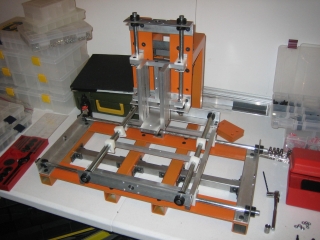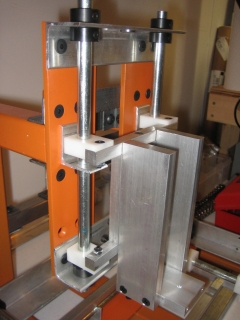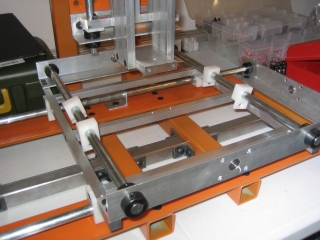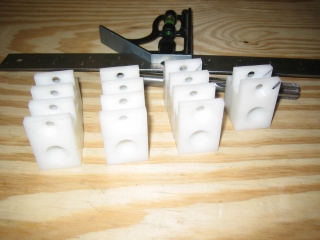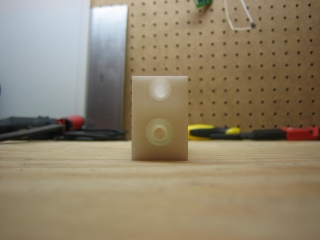Test Fitting
I have a majority of the mechanical framing components finished. Right now, I'm mostly just working on finish work and the drive parts (screws, nuts, motor couples, motor mounts).
These pictures show some of my test fitting. The Z-axis came out very precise. Since all the parts are smaller, the accrued error didn't result in any fitting problems. The spindle mounts slide into the Z-axis sub-frame with absolutely zero play. They're so tightly fit, the screws holding the mounts to the sub-frame are really only needed to resist problems with vibration--they don't provide any structural support.
The X-table/Y-sub-frame, on the other hand, turned out to have more variability than I had hoped. The holes were spotted on a vertical mill, but we did have some difficulty squaring up the vise used to hold the material. The best we measured was about .002" difference over 12" of travel. The fitting, however, suggests there is more error in the holes than .002". Just eyeballing the error, it looks to be well over .01". My intuition suggests blaming the drilling part of the work. A few of the drill bits definitely seemed to like to cut with one flute more than the other, so there might have been some eccentricity in the holes.
At any rate, the test fitting is being used to find this error, and account for it in the final assembly. Using the findings in my fittings, I'm going to further finish the major components, and make allowances for the parts where I can't tweak a dimension to make it fit better.
At this point, my major defect isn't the precision of the parts. The 1/2" rods I'm using for linear guides seem to be binding on the plastic bearings more than expected. The bearings have disproportionately high static friction compared to the (almost non-existent) dynamic friction. I have applied a Teflon-based lubricant that is designed for road bike chains. It's designed to set up a waxy coating on the surface and resist buildup of particulate. It further reduced the dynamic friction to the point where light tap will keep the parts gliding. The static friction, however, is still unusually high.
Right now, I think this could be related to a surface-tension-like effect. The bearings are smoothly machined to be less than .001" larger than the rods. This has to have no perceptible play in order to keep the precision maximized.
I have a few tactics I'm going to try to resolve this. The first is to slightly bevel the edges meeting the rods. If that doesn't help, I might cut thin channels in the direction of the rod. Two or three might break up the surface tension/suction problem. More would reduce the surface contact.
Next, I'll consider buying new, more precise rods. The $5 plated rods from Menards have no claims on precision. I went back to search through their supply, and all of them had obvious problems with finish and precision. I might try drill rods. The chrome-plated steel rods from McMaster Carr are a little more expensive than I would consider worth just trying. If I go that far, I will probably work on trying to bore out the bearings to accept brass bushings.
Everything else up to this point has been pleasantly surprising. I've even thought that maybe I missed my calling to go into mechanical engineering.
